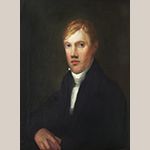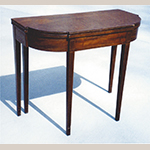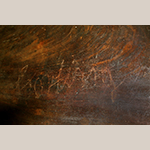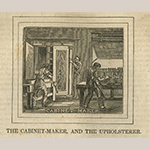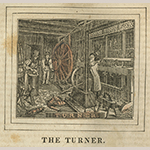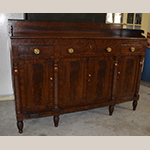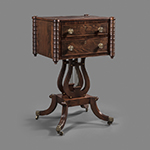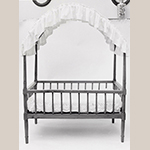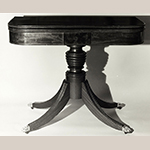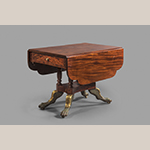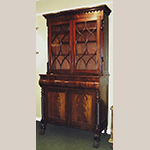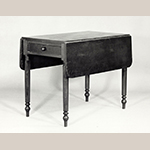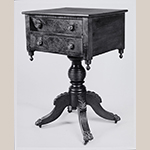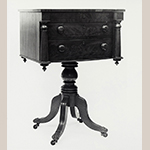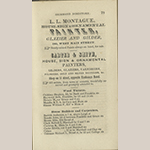This research note examines three sets of documents from the years 1825 to 1829 when wood turner Seth Haywood was working in the Richmond, Virginia cabinetmaking shop of Willis Cowling (Figure 1) and is an addendum to the author’s 2001 MESDA Journal article about Cowling (click here to read the original article).[1] The documents allow for a deeper understanding of Cowling’s business activities and provide a glimpse into how a specialized wood turner, Haywood, worked within an urban Virginia cabinetmaking shop. Specific types of turned elements completed by Haywood and prices for such work paid by Cowling are revealed through the documents. The documents also identify a number of previously unknown apprentices and enslaved artisans associated with Cowling’s shop.
Willis Cowling (working c.1810–1828) was a major cabinetmaker in the city of Richmond during the first decades of the nineteenth century. At the beginning of his career, his shop produced furniture such as the signed card table illustrated in Figure 2 and Figure 3. As the 1820s approached, Cowling created an entrepreneurial shop model during a transitional period for urban furniture makers in the South. In addition to producing furniture of his own, Cowling purchased pre-finished furniture parts from northern manufacturers to augment production in his shop (Figure 4).[2] Cowling also employed specialized artisans in his shop, such as the wood turner Seth Haywood (working c.1818–1849) (Figure 5).[3]
The two men probably became acquainted through their mutual relationship with cabinetmaker Robert Poore (working c.1802–1828). Cowling had multiple business and personal dealings with Poore from as early as 1817.[4] Seth Haywood was working with Poore as early as 1818 and would work as a turner in several of Richmond’s woodworking shops over the next three decades, including that of Willis Cowling, from 1825 to 1828.[5]
Articles of Agreement Between Seth Haywood and Willis Cowling
Willis Cowling’s papers are archived within the Richmond City records at the Library of Virginia. As highlighted in the 2001 MESDA Journal article, the Cowling Papers contain price lists detailing how much he would pay craftsmen for “Journey work,” reflecting Cowling’s exacting and fastidious model of record keeping for his shop.[6] Further evidence for Cowling’s meticulous accounting is the detailed agreement he created for turning work to be completed by Seth Haywood.
The survival rate of agreements such as the one between Cowling and Haywood, which were considered private contracts and did not have to be recorded in a public record, is exceedingly rare. The agreement document, which is also included in the Cowling Papers at the Library of Virginia, is dated 3 October 1825. The terms of the agreement include:
- Seth Haywood hath this day agreed to work at the Turning business for the said Cowling for two years—Haywood is to be under the control of the said Cowling in all things connected with the turning business
- Haywood is to furnish the tools that is wanted and furnish at his own expense a good shop
- He is also to teach a boy to turn for the said Cowling
- [Haywood] is to work Eleven Hours in every day through the year, Sunday only excepted and if through sickness or any thing else the [said] Haywood should lose any time it is understood and agreed that the said Cowling shall be allowed for Every Eleven Hours of Los[t] time two Dollars and Seventy five cents unless the time is made up in overwork
- Haywood is also to Keep a book of all the turning done in the shop but that done for the said Cowling
- Haywood is [to] do all in his power to promote the Interest of the said Cowling
- Cowling on his part Promises and agrees to give the said Haywood Seven Hundred Dollars for the two years to come from this time
- Cowling is to furnish a hand to turn the Wheel for the said Haywood and is also to furnish the Boy that the said Haywood is to teach the art of turning with all that he may want so that the said Haywood is to be at no Expense with him [7]
- Cowling is to furnish sand paper and oil when turning to make up the time before specfyd. p-day [sic]
The nine points in the agreement are quite specific, at times approaching pedantic. The exacting nature of the agreement may reveal more about Cowling’s doctrinaire personality and record keeping than a routine arrangement between artisans. Regardless, the list of Haywood’s obligations and Cowling’s responsibilities enrich any previous understandings and suppositions about such master-journeyman agreements.
Willis Cowling’s Estate Accounts
Willis Cowling’s will contained a codicil with directions to his executors:
It is my will & desire that my Cabinet-making business shall be carried on after my death as now under direction of my said executors, until the stock on hand shall be worked up into furniture, if they think it prudent to so to do.[8]
Because Cowling died leaving three minor children and his finances were in disarray, his executors continued to operate his cabinetmaking shop. His estate accounts document the workmen in the shop as well as the types of furniture produced. A surviving example from Cowling’s shop from the 1820s is the sideboard illustrated in Figure 6.[9] The turned columns and feet very well could have been produced by Haywood while working in Cowling’s shop. Cowling’s estate accounts show payment of $94.12 to Haywood for turning from 25 September 1828 through 13 May 1829.
Cowling’s estate accounts document that Haywood was part of a work force that included African American artisans, journeymen, and apprentices. In 1828 Cowling was taxed for seven enslaved persons over twelve years of age.[10] Cowling’s executors hired out Rose, Jacob, Kit, and Isaac.[11] The estate account entry for 11 September 1828 lists “pd Joe, Moses, Billy & Albert $1 each for weekly support.”[12] While there is only one mention of Billy, the accounts record continual support payments for the African American artisans Joe, Moses, and Albert.
Allowing enslaved persons to find food and lodging on their own were common hiring-out practices of urban antebellum Virginia.[13] Because a man identified as Stephen Cowley was paid sixty dollars in January 1829 for the hire of Joe, it is evident that Joe was owned by Cowley and not Willis Cowling.[14] An entry of 10 December 1828, “pd for clothing Albert, for services since the death of his master $7.50,” indicates that Albert was owned by Willis Cowling.[15] In Haywood’s subsequent lawsuit against Cowling’s executors there is an entry of 1 January 1828 for his hire of Moses for fifteen dollars.[16] This entry indicates Moses belonged to Cowling. Moses was paid a dollar for extra work on 23 September 1828 and on 22 November 1828 for extra work in the shop two dollars.[17]
Three apprentices—or, more accurately the cost of their room and board—were also recorded in Cowling’s estate accounts: John M. Cowling, Littleton Stewart, and William Hall. The first apprentice, John M. Cowling, was a nephew of Willis Cowling.[18] In the 1850 Federal Census for Nansemond County, Virginia, he was listed as a farmer.[19] Littleton Stewart would become a cabinetmaker and the 6 October 1837 issue of the semi-weekly Richmond Whig reported a fire that destroyed Stewart’s shop: “We regret to learn that the property to the amount of $7000 was destroyed, consisting of furniture, lumber and tools, belonging to Mr. Stewart’s estate.”[20] He died in 23 September 1837 at age twenty-seven.[21] In an agreement dated February 1826, William Hall of Hanover County, Virginia, was apprenticed to Willis Cowling to learn the trade of cabinetmaker until Hall reached legal age on 11 April 1832. The indenture stipulated that Hall’s guardian, John Thornton (also of Hanover County, Virginia), was to pay Cowling $40 per year for clothing Hall.[22] The last reference to William Hall is found in the 19 February 1829 entry of Cowling’s estate accounts: “By do. [cash] from John Thornton guardian Wm. Hall for clothing-per contract 80.-”.[23]
Besides Haywood, Cowling’s executors also employed journeymen and other cabinetmakers to keep his shop running. Isaac Cowling was paid one hundred four dollars for work done from 26 August 1828 to 23 February 1829. Isaac’s specific family connection to Willis is not known. E. M. Porter was paid $253 for work done from 26 August 1828 to December 1828. Porter was also paid for boarding Cowling’s three apprentices. John Binford was paid for his services in Cowling’s cabinet wareroom, where the public could view and purchase furniture.
The estate accounts also contains two lists of furniture. The first is an inventory of ready-made furniture in the shop at the time of Cowling’s death.[24] The existence of ready-made furniture is indicative of a cabinetmaker who had a warehouse to display items for purchase by the general public. While Cowling imported carved work and certain turned furniture parts from the North, there is no documentation that he was selling premade Northern furniture.[25] The second list is an inventory of furniture that was manufactured after Cowling’s death by the directive in his will.[26] Both lists give a “nominal” price and a “sale price” for each item. While there are no surviving account books for Willis Cowling’s shop, the two lists function as such for the business after Cowling’s death.
Haywood v. Cowling’s Executors Lawsuit
In the May 1832 Richmond City Hustings Court ended causes is the suit Haywood v. Cowling’s Executors. Haywood sued the executors of Willis Cowling’s estate for $310.49. The majority of this sum was for work done for Cowling from October 1827 to August 1828.[27] Cowling’s executors said that claim was accurate, but that Haywood owed Cowling $220.86. Cowling in his lifetime had advanced Haywood cash, paid for articles of clothing, paid for items of food, paid his rent for two years, paid his 1826 personal property tax, and in January 1828 hired out the enslaved Moses to him for $30. The executors claimed and proved that only $89.63 was owed to Haywood.
The important items in the case are two lists, which are basically the same, that provide an itemized description of the work done by Haywood from October 1827 to August 1828. It is unusual to find a continuous detailed account for work done for a cabinetmaker by a turner. The listing below presents types of turning done with comments as to the number of items produced and their prices. Examples of furniture exhibiting the types of turned work discussed are presented when possible. The illustrations are not of Haywood’s work—and not necessarily from Richmond—but are representative of turned work produced in a southern cabinetmaking shop from during the second quarter of the nineteenth century.
Columns: Haywood turned seventy-seven columns of which sixty-six have no description and five are described as “Beeded”. The cost of turning one column was twenty-five cents and the cost of turning a “Beeded” column was thirty-seven cents. The term “beeded” may refer to columns or half columns where the turning is a series of continuous rings. Examples of “beeded” columns can be seen on the sideboard in Fig. 6—probably Haywood’s turning work while employed by Cowling—and on the corners of a Baltimore sewing table (Figure 7) made for Mary Walker (Carter) Braxton (1763–1844) of Hybla Plantation in King William County, Virginia.[28]
Crib Posts: Twenty-eight crib posts were turned and four long crib posts were turned. The cost of turning four crib posts was $1.25 cents and the cost for four long crib posts was $1.75. A Virginia example featuring long crib posts is illustrated in Figure 8.
Crib Bannisters/Bannisters: Haywood turned 265 bannisters and forty-four crib bannisters. Because the cost of turning a bannister or a crib bannister was five cents, it is not clear if the terms are interchangeable. For crib bannisters, see Fig. 8
Pillars for Tables: There are three entries for seven table pillars and one entry for two small table pillars. The cost for turning one pillar for a table was seventy-five cents. These items were the support element of pillar and claw table. The table illustrated in Figure 9 is part of a group of tables attributed to Richmond, Virginia. The breakfast table illustrated in Figures 10 was made by Norfolk cabinetmaker James Woodward.
Pillars for Hat Stands/Hat Pins: On 27 October Haywood turned two pillars for a hat stand for one dollar and twelve hat pins for a total of fifty cents.
China Press Pillars: Twenty china press pillars were turned. Four pillars cost a total of sixty-seven cents and eight pillars cost a total of $1.33. A press by Petersburg cabinetmaker Joseph Badger with turned pillars is illustrated in Figure 11.
Stumps: The term “stumps” refers to a stump foot for case pieces. The District of Columbia cabinetmaker price book of 1831 described a bureau with stump feet.[29] Haywood turned 142 stumps and twelve small stumps.
Table Legs: Haywood turned 194 table legs. The cost for turning one table leg was twelve cents. Turned table legs can be seen on the Petersburg example made by William H. Badger illustrated in Figure 12.
High Post Beds: Sixty-four high post beds were turned, of which forty were made out of mahogany and twenty-four were made out of an undescribed wood. The cost for turning four mahogany high posts was $2.50. There was one exception for three dollars. The cost for turning four high posts of an undescribed wood was two dollars.
Work Table Legs: Haywood turned a total of sixteen work table legs. The total cost of turning eight legs was one dollar.
Roses: From 1827 to 1828 Haywood turned thirty “roses.” The 1831 District of Columbia price book lists a “French post Bedstead” and “rosetts on posts” and “Rosetts on scrool” for a “high post Bedstead.”[30]
French Posts: Haywood turned 169 posts for French bedsteads, sixteen of which were mahogany. The cost of turning four posts was one dollar. If the posts were mahogany, the cost for four posts was one $1.25. The four posts would indicate that this type of French bedstead was not a “sleigh bed” with curved sides.
Drops: Thirty-nine drops were turned. An 1818 New York cabinetmaker price book lists a pillar and claw card table with “drops.”[31] The term “drops” may refer to the pendant under each corner of the skirt of the card table (see Figure 13). The District of Columbia price book listing for a square dining table has an extra cost for “Veneering beads of drops.”[32]
Music Stools: Haywood turned three tops and screws for music stools. The cost of a top and screw was $1.50. He also turned twelve legs for music stools. The cost of four music stool legs was fifty cents.
Trundle Posts: For trundle bedsteads, Haywood turned twenty-eight posts. The total cost for turning four posts was fifty cents.
Secretary Pillars: Thirty-two secretary pillars were turned. Eight pillars cost a total of sixty-seven cents and sixteen pillars cost a total of $1.33 cents.
Bidet: Twelve legs for bidets were turned. The cost of turning four legs was fifty cents.
Bureaus Fronts: Heywood turned four sets of bureau fronts. The cost of two sets was fifty cents. He also turned seven sets of “draw” fronts. The cost of two sets of “draw” fronts was seventy-five cents. The distinction made between a bureau front and “draw front” is not clear. The turning of the front of a drawer would indicate a circular front rather than a flat drawer front. The District of Columbia price book listed as a feature for a full columned bureau “round drawers at top.”[33]
Blocks: Haywood turned three sideboard blocks for seventy-five cents and three blocks with no description for twenty-five cents apiece. The District of Columbia price book used the phrase “if round block prepared by turner” in connection with the base of a hat rack and a ladies’ work stand.[34]
Bed Pins: Bed pins are wooden knobs on the inside of the rails of a bedstead to which are attached the sacking or sail cloth to support the bed or mattress.[35] There is one entry for turning one set of bed pins for forty-two cents and another entry for a set for forty-eight cents.
Foot Stool: There is one entry for turning four foot stool legs for thirty-seven cents.
Urns: There are two entries for turning an urn for twelve cents and two entries for turning three urns for thirty-seven cents. The term “urn” may mean a “finial.”
Beeds: There is one entry for turning two-and-a-half feet of beeds and another entry for two feet of beeds. A work stand described in the District of Columbia price book had an entry for “putting astragal or be[a]d round bottom.”[36] This may have referred to a molding.
Pillar Stands: Haywood turned ten pillar stands, which are the turned supports for a small table (see Figure 14 for a Tidewater Virginia example).
Washstands: Haywood turned sixteen washstand legs and eight beaded washstand legs. Turning eight legs cost $1.33 cents and turning four beaded washstand legs cost $1.25 cents.
Piano Legs: Ten piano legs were turned. Turning one piano leg cost thirty-seven cents.
Conclusion
Little more is known about Haywood after the settlement of the lawsuit with Cowling’s executors until 1845 when he was listed in the 1845–1846 business directory for Richmond (Figure 15). His place of business was on West Franklin Street between Thirteenth and Fourteenth streets.[37] He was one of five turners listed in the business directory. The following notice appeared in the 13 July 1849 issue of the Richmond Whig, “Died, on July 5th, Seth Hayward, at his residence on Valley St.”[38] Haywood, like Cowling who had preceded him, found his final resting place in Shockoe Cemetery.[39]
Cabinetmakers did not operate in a vacuum and this is especially true of urban shops where there was a specialization of trades. In her article “Tilt-Top Tables and Eighteenth-Century Consumerism,” Sarah Neale Fayen points out that cooperation between trades was the most efficient and cost effective way to conduct business. She cites examples of Thomas Elfe, a Charleston, South Carolina cabinetmaker, paying William Payne for pillars for a tea table and paying Thomas Burton for carving a tea table.[40]
Not only do Willis Cowling’s papers allow us to see black and white artisans working in a specific cabinet shop producing specific furniture forms in the city of Richmond, the three sets of documents explored here provide a rare opportunity to view the detailed interaction between Seth Haywood, a specialized wood turner, with Willis Cowling, the master of a major early-nineteenth-century Virginia cabinetmaking shop.
J. Christian Kolbe is an emeritus research archivist at The Library of Virginia in Richmond. He can be contacted at [email protected]. He is much indebted to Ms. Cara Griggs for her editorial expertise.
[1] J. Christian Kolbe, “Willis Cowling (1788–1828): Richmond Cabinetmaker,” Journal of Early Southern Decorative Arts, Vol. 27, No. 2 (Winter 2001), 51–75. Available online: https://archive.org/stream/journalofearlyso2722001muse (accessed 3 October 2016).
[2] Ibid, 61-63.
[3] Haywood was apprenticed in 1813 by the Overseers of the Poor of Richmond to Thomas Cushing (working c.1812–1820), a local turner and cabinetmaker. At the time of his apprenticeship, Haywood, recorded as the orphan of Seth Haywood, was judged to be sixteen years old. Richmond City, Order Book, 1812-1813, 10: 213, Richmond City Microfilm Reel 82, Library of Virginia, Richmond.
[4] Poore and Cowling also shared a personal relationship: In his will, Cowling referred to Poore as his “esteemed friend” (Richmond City Hustings Court, Will Book No. 4, 1824–1828, p. 446). For more on Cowling’s relationship with Poore, see Kolbe, “Willis Cowling,” 55, 67.
[5] Haywood was listed as occupying a cabinetmaking shop with Poore in fire insurance policies in both 1818 and 1820. Policies #2569 and #2783, Mutual Assurance Society Declarations, Vol. 74, Accession 30177 and Vol. 75, Accession 30177, Miscellaneous Microfilm Reel 10, Library of Virginia, Richmond.
[6] Price lists reflect an attempt by masters of cabinetmaking shops in a town or city to control the wages of journeymen. For the price lists in the Cowling Papers, see Kolbe, “Willis Cowling,” 69-73.
[7] The description “hand to turn the Wheel” refers to a lathe with a great wheel as pictured in Fig. 5. Edward Hazen, The Panorama of Professions and Trades: Or, Every Man’s Book (Philadelphia, PA: U. Hunt, 1837), 219.
[8] Richmond City, Will Book, 1824-1828, 4:447, Richmond City Microfilm Reel 65, Library of Virginia, Richmond.
[9] Richmond City, Will Book, 1828-1832, 5:131-149, Richmond City Microfilm Reel 66, Library of Virginia, Richmond.
[10] Auditor of Public Accounts, Personal Property Tax, Richmond City, 1828, Personal Property Tax Records Microfilm Reel 364, 6, Library of Virginia, Richmond.
[11] Richmond City, Will Book, 1828-1832, 5:135 and 5:145, Richmond City Microfilm Reel 66, Library of Virginia, Richmond.
[12] Ibid, 138.
[13] John J. Zaborney, Slaves for Hire, Renting Enslaved Laborers in Antebellum Virginia (Baton Rouge, LA: Louisiana State University, 2012), 134-135.
[14] Richmond City, Will Book, 1828-1832, 5:144, Richmond City Microfilm Reel 66, Library of Virginia, Richmond.
[15] Ibid, 142.
[16] Haywood v. Cowling’s Exors.
[17] Richmond City, Will Book, 1828-1832, 5:140 and 5:142, Richmond City Microfilm Reel 66, Library of Virginia, Richmond.
[18] William Couper, “Couper Family,” Virginia Magazine of History and Biography, Vol. 59 (January 1951), 127
[19] 1850 Federal Census, Nansemond County, Virginia, population schedule, John M. Cowling family, 162.
[20] “Fire,” Richmond Whig (semi-weekly), 6 October 1837, p. 2-4.
[21] Death Notices from Richmond, Virginia Newspapers 1821-1840 (Richmond, VA: Virginia Genealogical Society, 1987), 290.
[22] Richmond City Court Records, Willis Cowling Papers, 11 April 1832, Box 1, Barcode 1117045, Library of Virginia, Richmond.
[23] Richmond City, Will Book, 1828-1832, 5:145, Richmond City Microfilm Reel 66, Library of Virginia, Richmond.
[24] Richmond City, Will Book, 1828-1832, 5:38-40, Richmond City Microfilm Reel 66, Library of Virginia, Richmond.
[25] Kolbe, “Willis Cowling,” 61-63.
[26] Richmond City, Will Book, 1828-1832, 5:41-43, Richmond City Microfilm Reel 66, Library of Virginia, Richmond.
[27] Haywood v. Cowling’s Exors.
[28] For provenance of the sewing table, see MESDA collection records, Acc. 5876.
[29] Wendell Garrett, “The Price Book of the District of Columbia Cabinetmaker, 1831,” The Magazine Antiques, Vol. 107, No. 5 (May 1975), 893.
[30] Ibid, 890.
[31] The New York Revised Prices for Manufacturing Cabinet and Chair Work (New York: Daniel D. Smith, 1818), 26.
[32] Garrett, 892
[33] Ibid, 893.
[34] Garrett, 891.
[35] Bradford L. Rauschenberg and John Bivins Jr., The Furniture of Charleston 1680–1820 (Winston-Salem, NC: Museum of Early Southern Decorative Arts, 2003), Vol. I, 428-429.
[36] Ibid.
[37] Ellyson, 79.
[38] Wesley E. Pippenger, comp., Death Notices from Richmond, Virginia Newspapers 1841-1853 (Richmond, VA: Virginia Genealogical Society, 2002), 309.
[39] Alice Bohmer Rudd, ed., Shockoe Hill Cemetery: Register of Internments, April 10, 1822-December 31, 1850 (Washington, DC: A. B. Rudd, 1960), Vol I, 6, 47.
[40] Sarah Neale Fayen, “Tilt-Top Tables and Eighteenth-Century Consumerism,” in American Furniture 2003, ed. Luke Beckerdite (Milwaukee, WI: Chipstone Foundation, 2003), 107–110.
© 2016 Museum of Early Southern Decorative Arts

